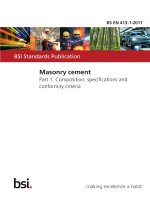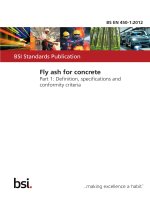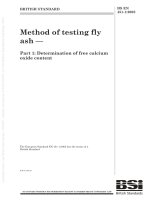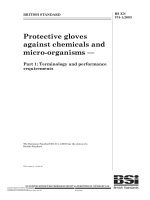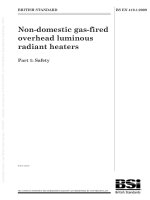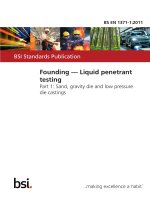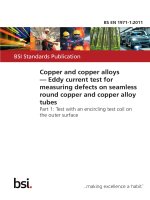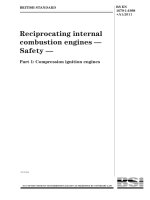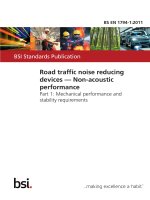Bsi bs en 61812 1 2011
Bạn đang xem bản rút gọn của tài liệu. Xem và tải ngay bản đầy đủ của tài liệu tại đây (1.35 MB, 52 trang )
BS EN 61812-1:2011
BSI Standards Publication
Time relays for industrial
and residential use
Part 1: Requirements and tests
BRITISH STANDARD
BS EN 61812-1:2011
National foreword
This British Standard is the UK implementation of EN 61812-1:2011. It is
identical to IEC 61812-1:2011. It supersedes BS EN 116000-2:1994 and BS EN
61812-1:1997, which are withdrawn.
The UK participation in its preparation was entrusted to Technical Committee
EPL/94, General purpose relays and reed contact units.
A list of organizations represented on this committee can be obtained on
request to its secretary.
This publication does not purport to include all the necessary provisions of a
contract. Users are responsible for its correct application.
© BSI 2011
ISBN 978 0 580 65856 3
ICS 29.120.70
Compliance with a British Standard cannot confer immunity from
legal obligations.
This British Standard was published under the authority of the Standards
Policy and Strategy Committee on 31 August 2011.
Amendments issued since publication
Amd. No.
Date
Text affected
BS EN 61812-1:2011
EUROPEAN STANDARD
EN 61812-1
NORME EUROPÉENNE
August 2011
EUROPÄISCHE NORM
ICS 29.120.70
Supersedes EN 61812-1:1996 + corr. Feb.1999 + A11:1999, EN 116000-2:1992
English version
Time relays for industrial and residential use Part 1: Requirements and tests
(IEC 61812-1:2011)
Relais à temps spécifié pour applications
industrielles et résidentielles Partie 1: Exigences et essais
(CEI 61812-1:2011)
Zeitrelais (Relais mit festgelegtem
Zeitverhalten) für industrielle
Anwendungen und
für den Hausgebrauch Teil 1: Anforderungen und Prüfungen
(IEC 61812-1:2011)
This European Standard was approved by CENELEC on 2011-06-29. CENELEC members are bound to comply
with the CEN/CENELEC Internal Regulations which stipulate the conditions for giving this European Standard
the status of a national standard without any alteration.
Up-to-date lists and bibliographical references concerning such national standards may be obtained on
application to the Central Secretariat or to any CENELEC member.
This European Standard exists in three official versions (English, French, German). A version in any other
language made by translation under the responsibility of a CENELEC member into its own language and notified
to the Central Secretariat has the same status as the official versions.
CENELEC members are the national electrotechnical committees of Austria, Belgium, Bulgaria, Croatia, Cyprus,
the Czech Republic, Denmark, Estonia, Finland, France, Germany, Greece, Hungary, Iceland, Ireland, Italy,
Latvia, Lithuania, Luxembourg, Malta, the Netherlands, Norway, Poland, Portugal, Romania, Slovakia, Slovenia,
Spain, Sweden, Switzerland and the United Kingdom.
CENELEC
European Committee for Electrotechnical Standardization
Comité Européen de Normalisation Electrotechnique
Europäisches Komitee für Elektrotechnische Normung
Management Centre: Avenue Marnix 17, B - 1000 Brussels
© 2011 CENELEC -
All rights of exploitation in any form and by any means reserved worldwide for CENELEC members.
Ref. No. EN 61812-1:2011 E
BS EN 61812-1:2011
EN 61812-1:2011
-2-
Foreword
The text of document 94/324/FDIS, future edition 2 of IEC 61812-1, prepared by IEC TC 94,
All-or-nothing electrical relays, was submitted to the IEC-CENELEC parallel vote and was approved by
CENELEC as EN 61812-1 on 2011-06-29.
This European Standard supersedes EN 61812-1:1996 + corrigendum February 1999 + A11:1999 and
EN 116000-2:1992.
EN 61812-1:2011 includes the following significant technical changes with respect to EN 61812-1:1996:
– update of references;
– addition of terms and definitions more commonly used by industry;
– addition of timing charts to help explain terms and definitions involving a sequence of events;
– renumbering of clauses to bring them into a more logical order;
– addition of provisions for residential use.
Attention is drawn to the possibility that some of the elements of this document may be the subject of
patent rights. CEN and CENELEC shall not be held responsible for identifying any or all such patent
rights.
The following dates were fixed:
– latest date by which the EN has to be implemented
at national level by publication of an identical
national standard or by endorsement
(dop)
2012-03-29
– latest date by which the national standards conflicting
with the EN have to be withdrawn
(dow)
2014-06-29
This European Standard has been prepared under a mandate given to CENELEC by the European
Commission and the European Free Trade Association and covers essential requirements of
EC Directive (2004/108/EC). See Annex ZZ.
Annexes ZA and ZZ have been added by CENELEC.
__________
-3-
BS EN 61812-1:2011
EN 61812-1:2011
Endorsement notice
The text of the International Standard IEC 61812-1:2011 was approved by CENELEC as a European
Standard without any modification.
In the official version, for Bibliography, the following notes have to be added for the standards indicated:
IEC 60060-1:2010
NOTE Harmonized as EN 60060-1:2010 (not modified).
IEC 60068-2-78:2001
NOTE Harmonized as EN 60068-2-78:2001 (not modified).
IEC 60664-4:2005
NOTE Harmonized as EN 60664-4:2006 (not modified).
IEC 60669-2-3:2006
NOTE Harmonized as EN 60669-2-3:2006 (not modified).
IEC 60721-3-3:1994
NOTE Harmonized as EN 60721-3-3:1995 (not modified).
IEC 60730-2-7:2008
NOTE Harmonized as EN 60730-2-7:2010 (modified).
IEC 60947-1:2007
NOTE Harmonized as EN 60947-1:2007 (not modified).
IEC 60947-5-1:2003
NOTE Harmonized as EN 60947-5-1:2004 (not modified).
IEC 61180-1:1992
NOTE Harmonized as EN 61180-1:1994 (not modified).
__________
BS EN 61812-1:2011
EN 61812-1:2011
-4-
Annex ZA
(normative)
Normative references to international publications
with their corresponding European publications
The following referenced documents are indispensable for the application of this document. For dated
references, only the edition cited applies. For undated references, the latest edition of the referenced
document (including any amendments) applies.
NOTE When an international publication has been modified by common modifications, indicated by (mod), the relevant EN/HD
applies.
Publication
Year
Title
EN/HD
Year
IEC 60050-444
2002
International Electrotechnical Vocabulary Part 444: Elementary relays
-
-
IEC 60050-445
2010
International Electrotechnical Vocabulary Part 445: Time relays
-
-
IEC 60068
Series Environmental testing
EN 60068
Series
IEC 60068-2-2
2007
Environmental testing Part 2-2: Tests - Test B: Dry heat
EN 60068-2-2
2007
IEC 60068-2-6
2007
Environmental testing Part 2-6: Tests - Test Fc: Vibration
(sinusoidal)
EN 60068-2-6
2008
IEC 60068-2-27
2008
Environmental testing Part 2-27: Tests - Test Ea and guidance:
Shock
EN 60068-2-27
2009
IEC 60085
2007
Electrical insulation - Thermal evaluation and EN 60085
designation
2008
IEC 60112
2003
Method for the determination of the proof and EN 60112
the comparative tracking indices of solid
insulating materials
2003
IEC 60529
1989
Degrees of protection provided by enclosures EN 60529
(IP Code)
+ corr. May
1991
1993
IEC 60664
Series Insulation coordination for equipment within
low-voltage systems
EN 60664-1
Series
IEC 60664-1
2007
Insulation coordination for equipment within
low-voltage systems Part 1: Principles, requirements and tests
EN 60664-1
2007
IEC 60664-3
2003
Insulation coordination for equipment within EN 60664-3
low-voltage systems Part 3: Use of coating, potting or moulding for
protection against pollution
2003
IEC 60664-5
2007
Insulation coordination for equipment within
low-voltage systems Part 5: Comprehensive method for
determining clearances and creepage
distances equal to or less than 2 mm
EN 60664-5
2007
IEC 60695-2-11
2000
EN 60695-2-11
Fire hazard testing Part 2-11: Glowing/hot-wire based test
methods - Glow-wire flammability test method
for end-products
2001
IEC 60695-10-2
2003
Fire hazard testing EN 60695-10-2
Part 10-2: Abnormal heat - Ball pressure test
2003
BS EN 61812-1:2011
EN 61812-1:2011
-5Publication
Year
Title
EN/HD
IEC 60947-5-4
2002
EN 60947-5-4
Low-voltage switchgear and controlgear Part 5-4: Control circuit devices and switching
elements - Method of assessing the
performance of low-energy contacts - Special
tests
2003
IEC 60999-1
1999
EN 60999-1
Connecting devices - Electrical copper
conductors - Safety requirements for screwtype and screwless-type clamping units Part 1: General requirements and particular
requirements for clamping units for conductors
from 0,2 mm² up to 35 mm² (included)
2000
IEC 61000-4-2
2008
Electromagnetic compatibility (EMC) EN 61000-4-2
Part 4-2: Testing and measurement
techniques - Electrostatic discharge immunity
test
2009
IEC 61000-4-3
2006
Electromagnetic compatibility (EMC) Part 4-3: Testing and measurement
techniques - Radiated, radio-frequency,
electromagnetic field immunity test
EN 61000-4-3
2006
IEC 61000-4-4
2004
Electromagnetic compatibility (EMC) Part 4-4: Testing and measurement
techniques - Electrical fast transient/burst
immunity test
EN 61000-4-4
2004
IEC 61000-4-5
2005
Electromagnetic compatibility (EMC) Part 4-5: Testing and measurement
techniques - Surge immunity test
EN 61000-4-5
2006
IEC 61000-4-6
2008
Electromagnetic compatibility (EMC) Part 4-6: Testing and measurement
techniques - Immunity to conducted
disturbances, induced by radio-frequency
fields
EN 61000-4-6
2009
IEC 61000-4-8
2009
Electromagnetic compatibility (EMC) EN 61000-4-8
Part 4-8: Testing and measurement
techniques - Power frequency magnetic field
immunity test
2010
IEC 61000-4-11
2004
EN 61000-4-11
Electromagnetic compatibility (EMC) Part 4-11: Testing and measurement
techniques - Voltage dips, short interruptions
and voltage variations immunity tests
2004
IEC 61210 (mod)
2010
EN 61210
Connecting devices - Flat quick-connect
terminations for electrical copper conductors Safety requirements
2010
IEC 61810-1
2008
Electromechanical elementary relays Part 1: General requirements
EN 61810-1
2008
IEC 61984
2008
Connectors - Safety requirements and tests
EN 61984
2009
IEC 62314
2006
Solid-state relays
EN 62314
2006
CISPR 11 (mod)
+ A1
2009
2010
Industrial, scientific and medical equipment - EN 55011
Radio-frequency disturbance characteristics - + A1
Limits and methods of measurement
2009
2010
CISPR 22 (mod)
2008
Information technology equipment - Radio
disturbance characteristics - Limits and
methods of measurement
EN 55022
2010
___________
Year
BS EN 61812-1:2011
EN 61812-1:2011
-6-
Annex ZZ
(informative)
Coverage of Essential Requirements of EC Directives
This European Standard has been prepared under a mandate given to CENELEC by the European
Commission and the European Free Trade Association and within its scope the standard covers all
relevant essential requirements as given in Article 1 of Annex I of EC Directive 2004/108/EC.
Compliance with this standard provides one means of conformity with the specified essential
requirements of the Directive concerned.
WARNING: Other requirements and other EC Directives may be applicable to the products falling within
the scope of this standard.
___________
–2–
BS EN 61812-1:2011
61812-1 IEC:2011
CONTENTS
1
Scope ............................................................................................................................... 7
2
Normative references ....................................................................................................... 7
3
Terms and definitions ....................................................................................................... 9
4
3.1 Terms and definitions related to general terms ........................................................ 9
3.2 Terms and definitions of relay types ...................................................................... 11
Influence quantities ........................................................................................................ 17
5
Rated values .................................................................................................................. 18
5.1
5.2
5.3
5.4
5.5
6
General ................................................................................................................. 18
Input voltage and frequency .................................................................................. 18
Release voltage .................................................................................................... 19
Power consumption ............................................................................................... 19
Output circuit ......................................................................................................... 19
5.5.1 Electromechanical output circuit ................................................................ 19
5.5.2 Mechanical endurance ............................................................................... 19
5.5.3 Solid state output circuit ............................................................................ 19
5.5.4 Endurance and operating frequency .......................................................... 20
5.5.5 Conditional short circuit current ................................................................. 20
5.6 Ambient temperature ............................................................................................. 20
5.7 Transport and storage temperature ....................................................................... 20
5.8 Humidity ................................................................................................................ 20
5.9 Pollution degree .................................................................................................... 21
5.10 Altitude .................................................................................................................. 21
5.11 Timing circuit function ........................................................................................... 21
5.11.1 General ..................................................................................................... 21
5.11.2 Setting accuracy ........................................................................................ 21
5.11.3 Repeatability ............................................................................................. 21
5.11.4 Recovery time and minimum control impulse ............................................. 21
Provisions for testing ...................................................................................................... 22
7
Documentation and marking ........................................................................................... 22
8
7.1 Data ...................................................................................................................... 22
7.2 Marking ................................................................................................................. 24
Heating .......................................................................................................................... 25
8.1
8.2
8.3
9
General ................................................................................................................. 25
Test conditions ...................................................................................................... 25
Heating of terminals .............................................................................................. 25
8.3.1 General ..................................................................................................... 25
8.3.2 Heating of screw terminals and screwless terminals .................................. 25
8.3.3 Heating of quick-connect terminations ....................................................... 26
8.3.4 Heating of sockets ..................................................................................... 26
8.3.5 Heating of alternative termination types ..................................................... 27
8.4 Heating of accessible parts ................................................................................... 27
8.5 Heating of insulating materials .............................................................................. 27
Basic operating function ................................................................................................. 27
9.1
9.2
General ................................................................................................................. 27
Operate ................................................................................................................. 27
BS EN 61812-1:2011
61812-1 IEC:2011
–3–
9.3
9.4
Release ................................................................................................................. 28
Time function ........................................................................................................ 28
9.4.1 Functional test at reference values of input quantities ............................... 28
9.4.2 Influencing effects of voltage and temperature ........................................... 28
10 Insulation ....................................................................................................................... 28
10.1 General ................................................................................................................. 28
10.2 Preconditioning ..................................................................................................... 29
10.3 Dielectric strength ................................................................................................. 29
10.3.1 General ..................................................................................................... 29
10.3.2 Impulse withstand test ............................................................................... 29
10.3.3 Dielectric a.c. power frequency voltage test ............................................... 30
10.4 Protection against direct contact ........................................................................... 31
11 Electrical endurance ....................................................................................................... 31
11.1 General ................................................................................................................. 31
11.2 Resistive loads, inductive loads, and special loads ................................................ 32
11.3 Low energy loads .................................................................................................. 32
12 Conditional short-circuit current ...................................................................................... 32
12.1 General ................................................................................................................. 32
12.2 Test procedure ...................................................................................................... 32
12.3 Test circuit electromechanical output circuit .......................................................... 32
12.4 Test circuit solid state output circuit ...................................................................... 33
12.5 Condition of switching element after test ............................................................... 34
13 Clearances and creepage distances ............................................................................... 34
13.1 General ................................................................................................................. 34
13.2 Creepage distances............................................................................................... 35
13.3 Clearances ............................................................................................................ 36
13.4 Measurement of creepage distances and clearances ............................................. 37
14 Mechanical strength ....................................................................................................... 37
14.1 General ................................................................................................................. 37
14.2 Mechanical strength of terminals and current-carrying parts .................................. 38
14.2.1 General ..................................................................................................... 38
14.2.2 Mechanical strength of screw terminals and screwless terminals ............... 38
14.2.3 Mechanical strength of flat quick-connect terminations .............................. 38
14.2.4 Mechanical strength of sockets .................................................................. 38
14.2.5 Mechanical strength of alternative termination types .................................. 38
15 Heat and fire resistance.................................................................................................. 38
16 Vibration and shock ........................................................................................................ 39
16.1 Vibration................................................................................................................ 39
16.2 Shock .................................................................................................................... 39
17 Electromagnetic compatibility (EMC) .............................................................................. 40
17.1
17.2
17.3
Annex A
General ................................................................................................................. 40
EMC immunity ....................................................................................................... 40
EMC radiated and conducted emission .................................................................. 42
(informative) Ball pressure test .............................................................................. 44
Bibliography .......................................................................................................................... 45
Figure 1 – Definition of ports ................................................................................................. 11
–4–
BS EN 61812-1:2011
61812-1 IEC:2011
Figure 2 – Definition of symbols ............................................................................................ 11
Figure 3 – Power on-delay relay ........................................................................................... 12
Figure 4 – Power off-delay relay ........................................................................................... 12
Figure 5 – Off-delay relay with control signal ........................................................................ 12
Figure 6 – On- and off-delay relay with control signal ............................................................ 13
Figure 7 – Flasher relay ........................................................................................................ 13
Figure 8 – Star-delta relay .................................................................................................... 14
Figure 9 – Summation time relay........................................................................................... 14
Figure 10 – Pulse delayed relay ............................................................................................ 15
Figure 11 – Pulse delayed relay with control signal ............................................................... 15
Figure 12 – Interval relay ...................................................................................................... 15
Figure 13 – Interval relay with control signal ......................................................................... 16
Figure 14 – Retriggerable interval relay with control signal on .............................................. 16
Figure 15 – Retriggerable interval relay with control signal off .............................................. 17
Figure 16 – Maintained time relay ......................................................................................... 17
Figure 17 – Test circuit electromechanical output, conditional short-circuit current ............... 33
Figure 18 – Test circuit solid state output, conditional short-circuit current ............................ 34
Table 1 – Influence quantities and reference values .............................................................. 17
Table 2 – Preferred values of endurance .............................................................................. 20
Table 3 – Preferred values of maximum permissible operating frequency.............................. 20
Table 4 – Recommended final values of the setting range .................................................... 21
Table 5 – Type testing .......................................................................................................... 22
Table 6 – Required relay information .................................................................................... 23
Table 7 – Areas and lengths of conductors dependent on the current carried by the
terminal ................................................................................................................................ 26
Table 8 – Temperature rise limits of accessible parts ............................................................ 27
Table 9 – Changing of influencing quantities ......................................................................... 28
Table 10 – Impulse test for basic insulation .......................................................................... 30
Table 11 – Dielectric test voltage for devices suitable for use in single-phase three or
two-wire a.c. and d.c. systems .............................................................................................. 30
Table 12 – Dielectric test voltage for devices suitable for use in three-phase four or
three-wire a.c. systems ......................................................................................................... 31
Table 13 – Minimum creepage distances for basic insulation ................................................ 36
Table 14 – Minimum clearances for basic insulation ............................................................. 37
Table 15 – Minimum clearances in controlled overvoltage conditions for internal
circuits .................................................................................................................................. 37
Table 16 – Environmental conditions influencing EMC .......................................................... 40
Table 17 – Immunity tests for industrial environments ........................................................... 41
Table 18 – Immunity tests for residential, commercial and light-industrial environments ........ 42
BS EN 61812-1:2011
61812-1 IEC:2011
–7–
TIME RELAYS FOR INDUSTRIAL AND RESIDENTIAL USE –
Part 1: Requirements and tests
1
Scope
This part of the IEC 61812 applies to time relays for industrial applications (e.g. control,
automation, signal and industrial equipment).
It also applies to time relays for automatic electrical controls for use in, on, or in association
with equipment for residential and similar use.
The term “relay” as used in this standard comprises all types of relays with specified time
functions, other than measuring relays.
NOTE Depending on the field of application of these relays (for example automatic electrical controls for
household and similar use, switches for household and similar fixed electrical installations), further standards may
be applicable, for example IEC 60730-2-7 or IEC 60669-2-3.
2
Normative references
The following referenced documents are indispensable for the application of this document.
For dated references, only the edition cited applies. For undated references, the latest edition
of the referenced document (including any amendments) applies.
IEC 60050-444:2002, International Electrotechnical Vocabulary – Part 444: Elementary relays
IEC 60050-445:2010, International Electrotechnical Vocabulary – Part 445: Time relays
IEC 60068 (all parts), Environmental testing
IEC 60068-2-2:2007, Environmental testing – Part 2-2: Tests – Test B: Dry heat
IEC 60068-2-6:2007, Environmental testing – Part 2-6: Tests – Test Fc: Vibration (sinusoidal)
IEC 60068-2-27:2008, Environmental testing – Part 2-27: Tests – Test Ea and guidance:
Shock
IEC 60085:2007, Electrical insulation – Thermal evaluation and designation
IEC 60112:2003, Method for the determination of the proof and the comparative tracking
indices of solid insulating materials
IEC 60529:1989, Degrees of protection provided by enclosures (IP Code)
IEC 60664 (all parts), Insulation coordination for equipment within low-voltage systems
IEC 60664-1:2007, Insulation coordination for equipment within low-voltage systems – Part 1:
Principles, requirements and tests
IEC 60664-3:2003, Insulation coordination for equipment within low-voltage systems – Part 3:
Use of coating, potting or moulding for protection against pollution
BS EN 61812-1:2011
61812-1 IEC:2011
–8–
IEC 60664-5:2007, Insulation coordination for equipment within low-voltage systems – Part 5:
Comprehensive method for determining clearances and creepage distances equal to or less
than 2 mm
IEC 60695-2-11:2000, Fire hazard testing – Part 2-11: Glowing/hot-wire based test methods –
Glow-wire flammability test method for end-products
IEC 60695-10-2:2003, Fire hazard testing – Part 10-2: Abnormal heat – Ball pressure test
IEC 60947-5-4:2002, Low-voltage switchgear and controlgear – Part 5-4: Control circuit
devices and switching elements – Method of assessing the performance of low-energy
contacts – Special tests
IEC 60999-1:1999, Connecting devices – Electrical copper conductors – Safety requirements
for screw-type and screwless-type clamping units – Part 1: General requirements and
2
2
particular requirements for clamping units for conductors from 0,2 mm up to 35 mm
(included)
IEC 61000-4-2:2008, Electromagnetic compatibility (EMC) –
measurement techniques – Electrostatic discharge immunity test
Part
4-2:
Testing
and
IEC 61000-4-3:2006, Electromagnetic compatibility (EMC) – Part 4-3: Testing and
measurement techniques – Radiated, radio-frequency, electromagnetic field immunity test
IEC 61000-4-4:2004, Electromagnetic compatibility (EMC) – Part
measurement techniques – Electrical fast transient/burst immunity test
4-4:
Testing
and
IEC 61000-4-5:2005, Electromagnetic compatibility
measurement techniques – Surge immunity test
4-5:
Testing
and
(EMC)
–
Part
IEC 61000-4-6:2008, Electromagnetic compatibility (EMC) – Part 4-6: Testing and
measurement techniques – Immunity to conducted disturbances, induced by radio-frequency
fields
IEC 61000-4-8:2009, Electromagnetic compatibility (EMC) – Part 4-8:
measurement techniques – Power frequency magnetic field immunity test
Testing
and
IEC 61000-4-11:2004, Electromagnetic compatibility (EMC) – Part 4-11: Testing and
measurement techniques – Voltage dips, short interruptions and voltage variations immunity
tests
IEC 61210:2010, Connecting devices – Flat quick-connect terminations for electrical copper
conductors – Safety requirements
IEC 61810-1:2008, Electromechanical elementary relays – Part 1: General requirements
IEC 61984:2008, Connectors – Safety requirements and tests
IEC 62314:2006, Solid-state relays
CISPR 11:2009, Industrial, scientific and medical equipment – Radio-frequency disturbance
characteristics – Limits and methods of measurement
Amendment 1 (2010)
CISPR 22:2008, Information technology equipment – Radio disturbance characteristics –
Limits and methods of measurement
BS EN 61812-1:2011
61812-1 IEC:2011
3
–9–
Terms and definitions
For the purposes of this document, the terms and definitions given in IEC 60050-444 and
IEC 60050-445, as well as the following apply.
NOTE Terms having the same or nearly the same meaning are printed in boldface on separate lines and can be
used as an alternative.
3.1
Terms and definitions related to general terms
3.1.1
time relay
specified-time relay
all-or-nothing relay (IEC 60050-444:2002, 444-01-02) with one or more time functions
[IEC 60050-445:2010, 445-01-01 modified]
3.1.2
specified time
specified characteristic of a time relay at given type of function, e.g. operate time, release
time, pulse on time, interval time
[IEC 60050-445:2010, 445-05-01]
3.1.3
setting accuracy
difference between the measured value of the specified time and the reference value set on
the scale
NOTE
For analogue setting this value relates to the maximum setting value.
[IEC 60050-445:2010, 445-06-07]
3.1.4
effect of influence (on specified time)
degree with which the influence quantity within its nominal range has an effect on the
specified time
[IEC 60050-445:2010, 445-06-02]
3.1.5
recovery time
minimum time interval for which the power supply is removed or control signal is applied or
removed before the specified function can be performed again
[IEC 60050-445:2010, 445-05-04]
3.1.6
minimum control impulse time
shortest duration of the power supply or control signal to fulfil the specified function
[IEC 60050-445:2010, 445-05-02]
3.1.7
repeatability
difference between the upper and lower limits of the specified confidence range determined
from several time measurements of a time relay under identical conditions
NOTE
Preferably the repeatability is indicated as a percentage of the mean value of all measured values.
[IEC 60050-445:2010, 445-06-08]
– 10 –
BS EN 61812-1:2011
61812-1 IEC:2011
3.1.8
power supply
energizing quantity
electrical quantity (e.g. electric current, voltage) which has to be applied or removed from the
input circuit of the time relay in order to enable it to fulfil its purpose
[IEC 60050-445:2010, 445-03-01]
3.1.9
input voltage
input current
electrical quantity that can be applied (or removed) to the power supply and to the control
signal
3.1.10
control signal
trigger signal (deprecated)
input signal which has to be applied or removed in addition to the power supply in order to
ensure a function of the time relay
NOTE
The control signal is provided by a separate device designed to close or open an electrical circuit.
[IEC 60050-445:2010, 445-02-05]
3.1.11
conditional short-circuit current of an output circuit
prospective electric current that a contact circuit, protected by a specified short-circuit
protective device, can satisfactorily withstand for the total breaking time of that protective
device under specified conditions of use and behaviour
[IEC 60050-445:2010, 445-04-03]
3.1.12
on-state voltage drop of a solid-state output circuit
voltage drop of a solid-state output circuit (deprecated)
voltage measured across the effectively conducting solid-state output of a time relay, when
carrying the given load current
[IEC 60050-445:2010, 445-04-04]
3.1.13
leakage current of a solid-state output
off-state current of a solid-state output (deprecated)
electric current which flows through the effectively non-conducting solid-state output of a time
relay at a specified voltage
[IEC 60050-445:2010, 445-04-05]
3.1.14
power port
point at which the supply voltage (either a.c. or d.c.) is connected to the time relay
[IEC 60050-445:2010, 445-07-01]
3.1.15
control port
additional port for the starting of functions whilst supply voltage is applied, or for the
connection of a remote potentiometer, control signal, etc.
NOTE
There are control ports for floating (potential-free) and non-floating control.
BS EN 61812-1:2011
61812-1 IEC:2011
– 11 –
[IEC 60050-445:2010, 445-07-02]
3.1.16
output port
port at which a load is connected to the time relay
NOTE
The output port could consist of electromechanical contacts or be a solid-state output.
[IEC 60050-445:2010, 445-07-03]
3.1.17
enclosure port
physical boundary of the time relay through which electromagnetic fields can radiate or
impinge
[IEC 60050-445:2010, 445-07-04]
NOTE
See Figure 1.
Enclosure port
Power port
Output port
Time relay
Control port
(if any)
IEC 792/11
Figure 1 – Definition of ports
3.2
Terms and definitions of relay types
Key
Power supply
Control signal
T
Setting time
Make contact
IEC 793/11
Figure 2 – Definition of symbols
3.2.1
power on-delay relay
on-delay relay
time relay in which the time delay starts when applying the power supply and the output
switches to the operate condition after the setting time has elapsed (see Figure 2 and
Figure 3)
BS EN 61812-1:2011
61812-1 IEC:2011
– 12 –
T
Time
IEC 794/11
Figure 3 – Power on-delay relay
[IEC 60050-445:2010, 445-01-02]
3.2.2
power off-delay relay
true off-delay relay
time relay in which the output immediately switches to the operate condition when applying
the power supply; the time delay starts when the power supply is removed; the output
switches to the release condition after the setting time has elapsed (see Figure 2 and
Figure 4)
T
Time
IEC 795/11
Figure 4 – Power off-delay relay
[IEC 60050-445:2010, 445-01-03]
3.2.3
off-delay relay with control signal
off-delay relay
time relay in which the output immediately switches to the operate condition when applying
the power supply and the control signal; the time delay starts when removing the control
signal, and the output switches to the release condition after the setting time has elapsed
(see Figure 2 and Figure 5)
NOTE
Effects of subsequent operating or resetting of the control signal should be declared by the manufacturer.
T
Time
IEC 796/11
Figure 5 – Off-delay relay with control signal
[IEC 60050-445:2010, 445-01-04]
BS EN 61812-1:2011
61812-1 IEC:2011
– 13 –
3.2.4
on- and off-delay relay with control signal
time relay in which the output switches to the operate condition when applying the power
supply and the control signal and after the setting time has elapsed; the output switches to
the release condition when the control signal is removed and after the setting time has
elapsed (see Figure 2 and Figure 6)
NOTE Effects of subsequent operating or retriggering of the control signal should be declared by the
manufacturer.
T
T
Time
IEC 797/11
Figure 6 – On- and off-delay relay with control signal
[IEC 60050-445:2010, 445-01-05]
3.2.5
flasher relay
repeat cycle relay
time relay in which the output periodically switches on and off as long as the power supply or
control signal is applied (see Figure 2 and Figure 7)
NOTE 1
Depending on the relay type, the output starts with "pulse on" or "pulse off".
NOTE 2
Flasher relay may also be initiated with a control signal.
T1
T2
T1
T2
T1
T2
t < T1
Time
IEC 798/11
Figure 7 – Flasher relay
[IEC 60050-445:2010, 445-01-06]
3.2.6
symmetrical flasher relay
symmetrical repeat cycle relay
flasher relay in which the output periodically switches on and off with substantially identical
durations of pulse on time and pulse off time
[IEC 60050-445:2010, 445-01-07]
3.2.7
asymmetrical flasher relay
asymmetrical repeat cycle relay
flasher relay in which the pulse on time and pulse off time are selectable separately
BS EN 61812-1:2011
61812-1 IEC:2011
– 14 –
[IEC 60050-445:2010, 445-01-08]
3.2.8
star-delta relay
time relay including two delayed outputs switching one after the other, for starting of motors in
the star mode and subsequent change to the delta mode (see Figure 2 and Figure 8)
NOTE The star and delta connections are defined in IEC 60050-141:2010, 141-02-06 and IEC 60050-141:2010, 141-0209 respectively.
TS
TD
Time
IEC 799/11
Figure 8 – Star-delta relay
[IEC 60050-445:2010, 445-01-09]
3.2.9
summation time relay
time relay in which the output switches when the setting time has elapsed by summation of
the time periods during which the control signal has been applied (see Figure 2 and Figure 9)
T1
T2
T = T1
+ T2
Time
IEC 800/11
Figure 9 – Summation time relay
[IEC 60050-445:2010, 445-01-10]
3.2.10
pulse delayed relay
time relay in which the time delay starts when applying the power supply; the output
momentarily switches for an interval to the operate condition after the time delay has elapsed
(see Figure 2 and Figure 10)
NOTE
Manufacturer should specify if interval is fixed or variable.
BS EN 61812-1:2011
61812-1 IEC:2011
– 15 –
T
Time
IEC 801/11
Figure 10 – Pulse delayed relay
[IEC 60050-445:2010, 445-01-11]
3.2.11
pulse delayed relay with control signal
time relay in which the time delay starts when applying the power supply and the control
signal; the output momentarily switches for an interval to the operate condition after the
setting time has elapsed (see Figure 2 and Figure 11)
NOTE 1
Cycling the control signal during the time delay will not retrigger the time delay.
NOTE 2
Manufacturer should specify if interval is fixed or variable.
T
Time
IEC 802/11
Figure 11 – Pulse delayed relay with control signal
[IEC 60050-445:2010, 445-01-12]
3.2.12
interval relay
time relay in which the output immediately switches to the operate condition and the time
delay starts when applying the power supply, and the output switches to the release condition
after the setting time has elapsed (see Figure 2 and Figure 12)
T
Time
IEC 803/11
Figure 12 – Interval relay
[IEC 60050-445:2010, 445-01-13]
BS EN 61812-1:2011
61812-1 IEC:2011
– 16 –
3.2.13
interval relay with control signal
single shot relay
time relay in which the output immediately changes to the operate condition and the time
delay starts when applying the power supply and the control signal; the output switches to the
release condition after the setting time has elapsed (see Figure 2 and Figure 13)
NOTE
Cycling the control signal during the time delay will not retrigger the time delay.
T
T
Time
IEC 804/11
Figure 13 – Interval relay with control signal
[IEC 60050-445:2010, 445-01-14]
3.2.14
retriggerable interval relay with control signal on
watchdog relay
time relay in which the output immediately switches to the operate condition and the time
delay starts when applying the power supply and the control signal; the output switches to the
release condition after the setting time has elapsed and if the control signal is not operated
during the setting time (see Figure 2 and Figure 14)
NOTE
Cycling the control signal during the time delay will retrigger the time delay.
T
t
T
Time
IEC 805/11
Figure 14 – Retriggerable interval relay with control signal on
[IEC 60050-445:2010, 445-01-15]
3.2.15
retriggerable interval relay with control signal off
fleeting off delay relay
time relay in which the output immediately changes to the operate condition and the time
delay starts when applying the power supply and removing the control signal; the output
switches to the release condition after the setting time has elapsed (see Figure 2 and
Figure 15)
NOTE
Cycling the control signal during the time delay will retrigger the time delay.
BS EN 61812-1:2011
61812-1 IEC:2011
– 17 –
T
t
T
Time
IEC 806/11
Figure 15 – Retriggerable interval relay with control signal off
[IEC 60050-445:2010, 445-01-16]
3.2.16
maintained time relay
time relay which does not prematurely release if the energizing quantity is removed and the
time interval is not concluded (see Figure 2 and Figure 16)
T
Time
IEC 807/11
Figure 16 – Maintained time relay
[IEC 60050-445:2010, 445-01-17]
4
Influence quantities
The specified performance of a relay shall be given with respect to the reference conditions,
i.e. the set of reference values of all influence quantities.
Unless otherwise explicitly stated by the manufacturer, the values and tolerance ranges listed
in Table 1 apply.
Table 1 – Influence quantities and reference values
Influence quantities
Reference values for
tests
Tolerances during tests
Ambient temperature
23 °C
± 5 °C
Air pressure
96 kPa
± 10 kPa
Relative humidity
50 %
± 25 %
Position
As indicated by the
manufacturer
2° in any direction
Input voltage
Rated value(s)
± 5 % for steady-state
conditions a
Output circuit
(voltage/current)
Rated value(s)
± 5 % for steady-state
conditions
Frequency
As indicated by the
manufacturer
±1%
BS EN 61812-1:2011
61812-1 IEC:2011
– 18 –
Influence quantities
Reference values for
tests
Tolerances during tests
Waveform
Sinusoidal
Maximum distortion factor
5%b
Direct component in a.c.
As indicated by input
voltage
Max. 2 % of peak value
Alternating component in
d.c. (ripple)
As indicated by input
voltage
Maximum 6 %
Shock and vibration
As indicated by the
manufacturer
Maximum 1 m/s²
Industrial and other
atmospheres
Clean air
Clean air (pollution not
exceeding class 3C2 of
IEC 60721-3-3)
a
In so far as they are regarded as influencing quantities in the case of time errors
tolerance to be ± 1 %.
b
Distortion factor: ratio of the harmonic content obtained by subtracting the
fundamental wave from a non-sinusoidal harmonic quantity and the r.m.s. value
of the non-sinusoidal quantity. It is usually expressed as a percentage.
c
For calculating the ripple content of d.c. (expressed as a
following formula applies:
maximum instantaneous value − minimum instantaneous value
d. c. value
5
c
percentage) the
× 100
Rated values
5.1
General
The numerical values given in this standard are either recommended standard values or
typical practical values for electronic and electromechanical time relays at the known state of
the art. The corresponding actual values for any specific product should be confirmed by the
manufacturer as complying with this standard or quoted explicitly if they deviate from this
standard.
5.2
Input voltage and frequency
a) The recommended a.c. rated input voltage r.m.s. is to be specified according to one of the
following values:
12 V; 24 V; 48 V; 100 V; 110 V; 115 V; 120 V; 127 V; 200 V; 208 V; 220 V; 230 V; 240 V;
277 V; 400 V; 415 V; 480 V.
b) The recommended d.c. rated input voltage is to be specified according to one of the
following values:
5 V; 12 V; 24 V; 48 V; 60 V; 100 V; 110 V; 125 V; 220 V; 250 V.
c) Rated frequency, recommended values: 50 Hz, 60 Hz, 400 Hz.
d) Rated input voltage range (for example 220 V to 240 V) and corresponding frequencies
(for example 50 Hz/60 Hz) shall be specified by the manufacturer.
e) The recommended operating range is to be specified according to one of the following
values:
•
80 % to 110 % or
•
85 % to 110 % or
•
90 % to 110 % of input voltage.
The above values apply over the full ambient temperature range as declared by the
manufacturer.
BS EN 61812-1:2011
61812-1 IEC:2011
– 19 –
Where the manufacturer deviates from the recommended range, both the rated input voltage
(or range) and the corresponding operative range shall be specified.
5.3
Release voltage
The release voltage shall not be less than 10 % of the minimum rated input voltage that is
specified according to 5.2.
NOTE
Higher values can be stated upon agreement between manufacturer and user.
The release voltages apply over the full ambient temperature range as declared by the
manufacturer.
5.4
Power consumption
The rated power consumption of a relay shall be given at rated input voltage. In case of relays
with several input circuits, the respective rated power consumption shall be given.
NOTE For relays with an input which varies depending on the position of the moved parts or for any other reason,
the higher value should be given in VA or in W. In the case of alternating current the power factor is optional.
5.5
Output circuit
Output load ratings shall be specified by the manufacturer.
5.5.1
Electromechanical output circuit
a) Resistive loads, inductive loads, and special loads (e.g. lamp loads, cable loads) shall be
specified in accordance with 5.7, Annex B and Annex D of IEC 61810-1:2008.
The manufacturer shall state the following:
•
rated load values for the output circuits;
•
number of cycles for electrical endurance;
•
number of cycles for mechanical endurance;
•
frequency of operation.
b) Low energy loads (for example electronic systems and programmable controllers) shall be
specified in accordance with IEC 60947-5-4. The manufacturer shall state the rated load
values and statistical assessed constant mean number of operating cycles (m c ). The
following examples are preferred formats for specifying rated load values:
•
minimum voltage and current (for example 24 V, 1 mA);
•
minimum power (for example 50 mW, 5 V / 5 mA), meaning with 5 V the current shall
be at least 10 mA, or with 5 mA the voltage shall be at least 10 V.
5.5.2
Mechanical endurance
Mechanical endurance value of the internal relay shall be used. As an alternative the
manufacturer may perform a mechanical endurance test according to IEC 61810-1.
5.5.3
Solid state output circuit
Load categories shall be specified in accordance with 4.4 of IEC 62314:2006 as applicable.
The manufacturer shall state the maximum value of
• voltage drop at rated load current;
• leakage current at maximum specified ambient temperature.
BS EN 61812-1:2011
61812-1 IEC:2011
– 20 –
5.5.4
Endurance and operating frequency
The preferred values of the endurance and operating frequency are given in Table 2 and
Table 3.
Table 2 – Preferred values of endurance
Operating cycles × 10 6
0,03
0,1
0,2
0,3
0,5
1
3
10
20
30
Table 3 – Preferred values of maximum permissible operating frequency
Operating frequency under
load conditions (cycles per hour)
a
12
30
120
300
600
1 200
1 800
3 600
7 200
a
This applies only in so far as
permissible due to the shortest
adjustable time delay.
5.5.5
Conditional short circuit current
When protected by a short-circuit protective device e.g. 6,3 A quick response fuse, the rated
conditional short-circuit current of a relay is a minimum value of 100 A.
5.6
Ambient temperature
Unless otherwise stated, the preferred ambient temperature range is –10 °C to +40 °C for the
operation of relays.
5.7
Transport and storage temperature
Equipment subjected to these extreme temperatures without being operated shall not undergo
any irreversible damage and shall then operate normally under the specified conditions.
Temperature range for:
• storage: –25 °C to +55 °C;
• transport: –40 °C to +70 °C.
5.8
Humidity
Unless otherwise stated, the preferred relative humidity range is 25 % to 75 %.
